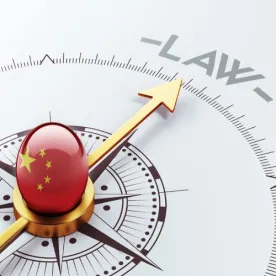On September 11, 2020 (and effective September 12, 2020), the Supreme People’s Court of China released the Provisions on Several Issues Concerning the Application of Law in Trial of Civil Cases of Infringement (Theft) of Trade Secrets (审理侵犯商业秘密民事案件适用法律若干问题的规定). This judicial interpretation of the Anti-Unfair Competition Law and the Civil Procedure Law clarifies the definition of trade secrets in civil litigation and how theft of trade secrets should be handled in civil litigation in China.
Article 1 clarifies that definition of trade secrets as used in Article 9 of the Anti-Unfair Competition Law. Specifically, Article 9 in the Anti-Unfair Competition Law states that trade secrets can include technical information. Article 1 of the Provisions defines technical information as “information related to technology such as structures, raw materials, components, formulas, materials, samples, patterns, propagation materials of new plant varieties, processes, methods or their steps, algorithms, data, computer programs and related documents.”
Further, business information referenced in Article 9 of the Anti-Unfair Competition Law is clarified as “business activities, such as innovation, management, sales, finance, plans, samples, bidding materials, customer information, and data.” Customer information includes “customer’s name, address, contact information, transaction habits, intentions, and other information.”
However, in Article 2, a specific customer is not necessarily a trade secret based only on the grounds of a long-term stable trading relationship between vendor and customer. “If a customer conducts transactions with an employer based on personal trust in the employee, and after the employee resigns, the employee can prove that the customer voluntarily chooses to trade with the employee or the employee’s new employer, the people’s court shall determine that the employee did not use improper means to obtain the right holder’s trade secret.”
Per Article 4, relevant information is known to the public under any of the following circumstances and therefore not a trade secret:
(1) The information belongs to common sense or industry practice in the field;
(2) The information only relates to the size, structure, and the simple combination of materials and components that can be directly obtained by relevant personnel in the field by observing the products at issue;
(3) The information has been publicly disclosed in publications or other media;
(4) The information has been disclosed through public reports, exhibitions, etc.;
(5) The relevant personnel in the field can obtain the information from other public channels.
Under Article 6, any of the following will be considered sufficient to safeguard a trade secret (as required by the Anti-Unfair Competition Law to be considered protected as a trade secret):
(1) Signing a confidentiality agreement or stipulating confidentiality obligations in a contract;
(2) By means of articles of association, training, rules and regulations, written notifications, etc., confidentiality requirements are imposed on employees, former employees, suppliers, customers, visitors, etc. who can access and obtain trade secrets;
(3) Restrict visitor’s access to factories having trade secrets or use different management for the factories;
(4) Limit access to media holding trade secrets as well marking, classifying, isolating, encrypting, sealing the media;
( 5) Taking measures such as prohibiting or restricting the use, access, storage, and copying of computer equipment, electronic equipment, network equipment, storage equipment, software, etc. that can access and obtain trade secrets;
(6) Require ex-employees to register, return, and destroy the trade secrets and media holding trade secrets that they have obtained, and continuing to assume the obligation of confidentiality;
(7) Taking other reasonable confidentiality measures.
Per Article 9 of the Provisions, indirect use or modification of a trade secret is still theft (infringement) of a trade secret.
Per Article 14, information is not protected as a trade secret if it can be determined by reverse engineering or independent development. Reverse engineering includes “disassembly, surveying, mapping, and analysis of a product obtained from public channels through technical means to obtain relevant technical information of the product.”
Per Mark Cohen, former U.S. IP Attaché to China and currently at Berkeley, this “should reduce the viability of defenses based on changes to technology made by the alleged misappropriator which had subsequently given rise to overly broad reverse engineering defenses in China” as it replaces a broader defense clause in a prior draft.
The Provisions also discuss remedies, including return/destruction of trade secrets (Article 18), damages when the trade secret becomes public (Article 19), and damages based on the right holder’s losses (Article 20).
Article 22 provides that evidence from a corresponding criminal trade secret theft case may be used in a civil litigation unless it will affect the outcome of a criminal trial. Accordingly, parties to the civil litigation can request suspension of the civil litigation until the criminal trial concludes (Article 25).
The full text of the 29 Articles is available on the Supreme People’s Court website here (Chinese only).



 />i
/>i
